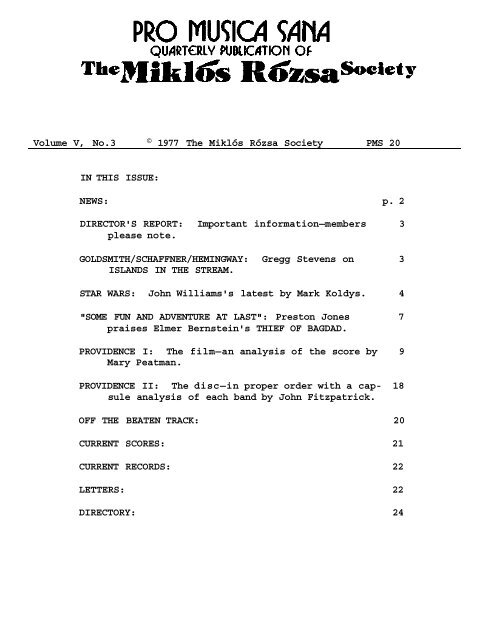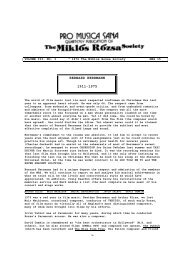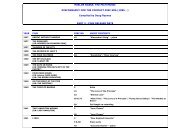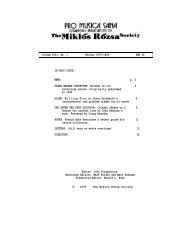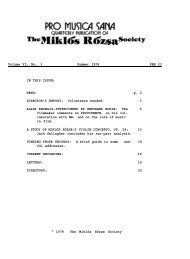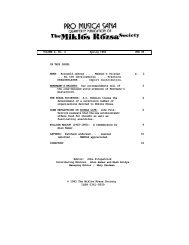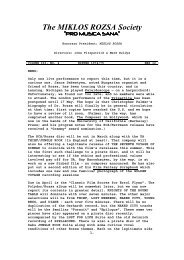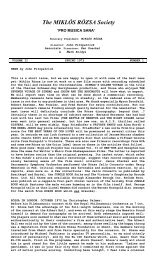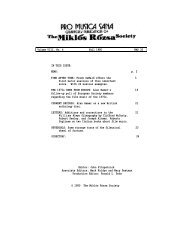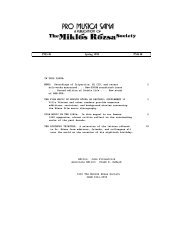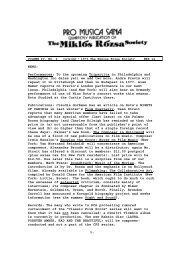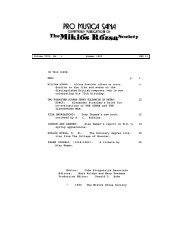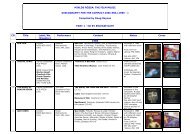You also want an ePaper? Increase the reach of your titles
YUMPU automatically turns print PDFs into web optimized ePapers that Google loves.
score, with its roots more in the '40s than the '70s, being released in atwo-disc album, and the album subsequently soaring up the best-sellercharts, approaching the million-sales mark. And many would be even moresurprised to find the composer of this work to be Mr. John Williams, whosecareer, though one with a number of successes, cannot be called consistent.And yet all this has come together, in the form of what may well bethe most popular film in history, STAR WARS, an open-hearted evocation ofmany of the most pleasantly familiar conventions of "the movies," with acinematic virtuosity that reveals new skills in director-writer GeorgeLucas.Williams's score is an impressive achievement, its surging, dramaticcharacter at times reminiscent of Korngold, but tempered with the harmonicand melodic freedom of, say, Stravinsky. The composer relies heavily onleitmotifs, and all are apposite. The young hero Luke Skywalker is representedby a vibrant, masculine theme, which, with its wide leaps andrhythmic pattern, is similar in conception, if not in sound, to Rózsa'stheme for Ben-Hur:The Princess Leia receives the most romantic music in the score, describedby the composer as a "fairy-tale-type princess melody":Ben (Obi-Wan) Kenobi's theme also doubles as a thematic representation ofthe all-pervading field of energy called "The Force":Also assigned individual motivic cues are Lord Darth Vader, the Jawa people,and the ultimate weapon, the Death Star.Although Williams's leitmotifs are clearly associated with theircharacters, they are used freely in the film. Often Williams scoresscenes with themes of characters who are not prominently involved, or evenpresent at the time; this is done not only to utilize the specific soundof a theme where its musical character would better fit a scene, but alsoto provide additional layers of significance to the musical commentary.For example, early in the film, as Luke watches the sunset, thinking aboutleaving the desert planet of Tatooine, the soundtrack plays a vibrantstring orchestra variation of Ben Kenobi's theme, and he hasn't even appearedin the film yet! The result is not only that the minor-mode characterof this theme gives the scene a sense of melancholy that Luke's themewould have overlooked, but also that the Ben Kenobi theme acquires abroader significance, perhaps as a representation of the benevolent influenceof "The Force." The most effective use of this technique occurs in a-5-
later sequence, which is the dramatic high point of the score, and one ofthe most effective scenes in the entire film, thanks (at least in part)to Williams's music. Ben Kenobi is fighting a duel with villain LordVader; Ben deliberately loses the duel, diverting attention from theheroes boarding their spaceship to escape. Just before Ben is struckdown, his theme is played softly on French horn. As he is killed, Lukecries out "No!" and there is a brief ray-gun battle before the ship makesgood its escape. From Luke's cry through the battle, Williams scoresthis scene not with the agitato music one might expect, but rather withan emotional, full-orchestra rendition of Princess Leia's theme that iselectrifyingly moving. Thus the music reflects not so much the on-screenaction but rather the emotions of the characters at that moment. Of allthe characters, the Princess is the least involved in this scene, yet hertheme is undeniably "right" in this context. Williams explains: "I feltthe Princess's theme had the most sweeping melody of all the themes inthe score. This wildly romantic music in this tragic setting representsLuke's and the Princess's reaction to leaving Ben behind."The score's effectiveness is not limited to these two scenes. Fromthe opening legend to the final throne room scene (a visual recreationof a sequence from TRIUMPH OF THE WILL), for which Williams provides amelody of true Elgarian pomp, the score is a marvel of invention, melody,and timing. Those in Los Angeles, San Francisco, and New York see STARWARS in a multiple-channel 70mm version that uses the Dolby system to bringthe cinematic sonics to a new state-of-the-art. Some other cities receivea 35mm Dolby-processed two-channel optical print that also presentsthe score in stereophonic sound and with admirable clarity. Now, however,20th Century-Fox has released standard 35mm monophonic-sound prints; theinterested filmgoer should attempt to hear the score in one of the twostereophonic versions noted above to fully appreciate the impact of STARWARS.For those as excited about this work as I am, 20th Century-Fox recordshas released a generous two-disc set (listed at only $8.95) thatcontains 74 of the score's 90 minutes of music, including some not usedin the final cut of the film. John Fitzpatrick complains elsewhere inthis issue about the practice of rearranging the order of sound trackselections for "better listening," but there can be no complaints abouthow composer John Williams has edited STAR WARS for records. The phonographis a different medium, after all, and the sequence of a film maynot be ideal for a discs in the case of STAR WARS, all selecting, combining,and rearranging was done by the composer himself, with the resultthat STAR WARS on disc sustains interest throughout its four sides.(Thereis so much chronological alteration—one band contains music from atleast half a dozen scenes — that enumeration of the changes is beyondthe scope of this commentary.) The extensive annotations by the composerdelineate the origins of most of what is heard, the London Symphony playsup a storm, and the recordings are impeccable in sound and processing.20th Century 2T-541 should be an essential acquisition for the collectorwho wants a flawless representation of what is the odds-on favorite forOscar-winning score of the year.-6-
"SOME FUN AND ADVENTURE AT LAST"--BERNSTE<strong>IN</strong>'S THIEF OF BAGDADby Preston Neal Jones:The only major problem with Elmer Bernstein's recording of THE THIEFOF BAGDAD is that Miklós Rózsa wrote too much good music for the originalscore. Although no timings are offered, there are at least forty minutesof music here, and, even at that, another album's worth of beautiful materialhas been left out. To my thinking, Rózsa's score comprises so manygems that the decision of what to include and what to leave out becomesvirtually arbitrary—no matter what might be excluded, whatever would remaincould not help but shine—and so it is with this record.THIEF, perhaps the most generously melodic film score until Rózsa'sown BEN-HUR, presented a formidable challenge to those who had to shrinkthis djinn-sized opus into bottle size for a single disc. One of thequestions to be considered was whether to incorporate material from thepreviously recorded suites or to concentrate solely on never-recordedselections. The former course was followed, at the cost of ignoring manyof the unrecorded treasures, but, it must be admitted, to the overall advantageof the album. To have entirely avoided suite selections wouldhave crippled some of the new material. The "Sailor's Song," for instance,would not have been nearly as effective without the surrounding "HarborScene," and it is wonderful to hear these two pieces restored to theirproper interrelation on this record. What Bernstein's album offers, therefore,is neither a rehash of the suite nor an all-out attempt to presentthe previously unrecorded material, but rather a Readers Digest CondensedBooks version that admirably conveys, within its obvious limitation of time,the overall flavor of Rózsa's early masterwork. The disc offers at least alittle, and in some cases a lot, of every mood to be found in the originalscore. (Every mood, that is, save one: Rózsa's inimitable Oriental/Hungarian melancholy, as exemplified by such sequences as the blind Princeand the harem, the bittersweet reunion of the lovers, and, best of all, thePrincess and her father in the desolate garden.)The first band gets off to a slightly uneven start due to the suddenvolume drop when the fanfare gives way to an overly distant chorus. Butafter a few measures, both chorus and orchestra gain new vigor, andBernstein conducts the remainder of the record with assurance and expertise.(Despite this temporary lapse with the chorus, Bernstein and engineerKeith Grant seem to have mastered the miking problems that affectedthe choral/orchestral balance on the WUTHER<strong>IN</strong>G HEIGHTS album.) Occasionally,an orchestral imbalance will obscure an important melodic element,but for the most part Bernstein guides his players in a performance thatsplendidly captures the sound and spirit of the original sound track.Among the vocal soloists, I give highest marks to Bruce Ogston,whose superlative rendition, strong, yet lyrical, of the "Sailor's Song"recreates the magic of this thrilling, unusual opening to the 1940 film.Phyllis Cannan fares less well, I feel, with the love song, although herperformance is technically adequate. I much prefer the simple purityof the film's Adelaide Hall to Cannan's slightly mannered diction andforced projection. The beauty of Rózsa's melody comes through, but notthe feeling; the listener is never quite able to lean into the song andrelax with it as was the case with the original version, which is a pity,since Bernstein's handling of the instrumental and choral support is justright. Least successful in the singing department, however, is PowellJones, whose interpretation of Abu's song could most charitably be calledill-advised. He sounds as if his voice would have served just fine had-7-
"The Golden Tent" also impresses more than in 1940, mostly becausethe dialogue, of necessity, took precedence over Rózsa's exquisitevocalise. Heard by itself, this music is something of a revelation inits gentle textures, which would not sound out of place in the Christmasseason. The final band, like the record itself, engages in abridgementyet manages through a fine orchestral reading to communicate the marvelsinherent in the music. As the chorus carries Abu and his carpet toward,as he puts it, "some fun and adventure at last," the listener knows thatthat is exactly what he has received in full measure from this recreationof Rózsa's magical score.Still more treasure remains for those adventurous enough to unearthit, and it is to be hoped that this is not the final word from THIEF ondiscs. In addition to some of the unrecorded passages mentioned above,there is the happy scene as Abu the dog entertains the citizenry, thepastorale as Abu shares his dreams of the sea with his fellow prisoner thePrince, the malevolence as the magician blinds the Prince and conjures Abuinto a canine, the joyous surge when the Prince regains his sight, and somany, many more (to say nothing of the portions deleted from the sequencesrecorded by Bernstein). Since, as Bernstein has written, THIEF has beenhis membership's most requested score, perhaps he waited this long to recordit so that he could utilize the kind of orchestra and chorus he didnot have at his disposal during the Filmmusic Collection's first years.Should he have waited still longer, until such time as his budget mighthave also permitted the double album this score actually deserves? I, forone, am deeply grateful for the present wonder Bernstein has wrought withinhis current resources. Is this record, as Alan Hamer predicted inPMS 19, "the film music album of the decade"? Well, it certainly is oneof them. And some day, perhaps on "the other side of time," the scorewill be recorded in what the old Sultan would call "the most complete completion,"and then we shall have one for the ages.PROVIDENCE I—THE FILM by Mary Peatman:Before I embark on PROVIDENCE proper, I feel that a few words aboutits director—including my own prejudices—are in order. The films ofAlain Resnais are not easy to get along with. I myself am deeply impressedwith some of them: I would defend HIROSHIMA MON AMOUR (his first feature,1959) as perhaps one of the best ten or even five films ever made, and Ithink STAVISKY ...is brilliant. Yet there are problems, too. LAST YEARAT MARIENBAD, valuable as an exploration into the potentials of cinematicnarrative, strikes me nonetheless as a limited experiment, and to myway of thinking, JE T'AIME JE T'AIME is simply bad. I also have doubtsabout his ever becoming a favorite of MRS members. I know of some wholike him, but not too many. This is understandable: all but one of hisfilms are in French, accessible to an American audience only through subtitles,themselves a nuisance, and his narrative structure is always verytaxing. But what must be understood is that the coming together of Resnaiswith Miklós Rózsa is an important event, even if neither produced his bestwork. It also constitutes a dramatic shift in Rózsa's output—an excursioninto a murkier stream of consciousness than ever Sinbad sailed.A major point that must be understood about Resnais is one too oftenneglected by critics: he is acutely attuned to music. He virtually thinks-9-
in musical terms; and this, plus his deep love and affinity for the comicstrip, forms a good part of the basis for his peculiar editing style.Modestly labeling himself a metteur-en-scene as opposed to an auteur (hesays he leans heavily on his writers, and there is no arguing the influenceof such individuals as Alain Robbe-Grillet and Marguerite Duras onhis films), he has an uncanny ear for the right composer as well, frequentlysitting down with him and indicating quite specific thoughtsabout the relationship of the music to the visuals. Though his musicaltraining itself is not extensive, he does have an excellent ear as wellas eye, and many of his films attest to this fact. It is unfortunatethat more has not been written on this aspect of Resnais's work (althoughHenri Colpi has contributed a fine essay on the music for HIROSHIMA MONAMOUR [mostly scored by Giovanni Fusco, not Georges Delerue]—seeDefense et illustration de la musique dans le film). Just to name otherResnais collaborators is enough to cause raised eyebrows: DariusMilhaud (GAUGU<strong>IN</strong>, a short), Hanns Eisler (NIGHT AND FOG, also a short),Hans Werner Henze (MURIEL OU LE TEMPS D'UN RETOUR), and most recently,Stephen Sondheim (STAVISKY...). Fusco scored one other film, LA GUERREEST F<strong>IN</strong>IE, and MARIENBAD contains heavy, almost non-stop organ music byFrancis Seyrig, an obscure French composer whose only other work in filmthat I know of is Robert Bresson's LE PROCES DE JEANNE D'ARC. Finally,mention might be made of Maurice Jarre's score for TOUTE LA MÉMOIRE DUMONDE, a documentary about the Bibliotheque Nationale made in 1956, beforeJarre was known in this country. STAVISKY... went over very well with thecritics and Resnais enthusiasts--it was a marvelous treat to get after afive-year wait—and Sondheim's score was a tour de force. It should bementioned that Sondheim was considered for PROVIDENCE as well, but since hewas busy elsewhere at the time, Rózsa was brought into the picture instead.Before leaving STAVISKY..., I think it important to give the followinginsight into Resnais's working methods with Sondheim on that film:"I knew all of [his] music; but the deeper I got into the Stavisky, themore I knew [it] was perfect. ... To give you an idea how important[it] was to me, when writing the shooting script I conceived certainkey scenes rhythmically, in terms of his music. And on the first day ofshooting, I had my tape recorder handy, with key passages of A LittleNight Music constantly in my ear."¹ In view of such working methods, itis hardly surprising to learn that Resnais also knew Rózsa's works.PROVIDENCE is a dark film in every sense of the word except filmnoir: it is not a crime drama. It is very moody, and most of it is notonly set at night but involves nocturnal or otherwise "dark" visions: ina forest; in a stadium under a very disturbing sky, a deep twilight graythat, while clearly artificially produced by filters and lenses, is nonethelessfrightening. And all the while we are crawling around in a sickman's brain. Rózsa's job, as Resnais specified to him, was to captureand reflect this mood, and Rózsa did just that. In his own words, thiswas "anti-BEN-HUR." Not until the very end, in an extraordinary shift ofmood, does the atmosphere clear, and even that doesn't last.As the credits roll against a black background, the music throbs inwhat could best be described as a funereal overture, slow, steady, repressed,and in a minor key. Low-pitched brass and percussion maintainthe march figure in the bass; the melody is carried by winds and strings.A brief "B" passage momentarily diverts us from this weighty opening, butsoon the main motif returns, carrying the passage to a pianissimo conclusion.The theme deserves to be quoted in full:-10-
Ex 1There are superficial resemblances to music Rózsa wrote for the mortalwounding of Henri II in DIANE, as people have noticed. While the melodyis different, the harmonic texture and the instrumentation, plus the heavyconsistent pulse, all bear close comparison. The "Providence" motif, asI will call it, is central to this score in a way that the funeral musicfrom DIANE is not, however; it recurs often in the film, serving to remindus even in the more cheerful moments that death is at hand.Following the title music, a quiet statement is heard on the clarinet:Ex 2The film opens with a shot of the house that serves as the main setting ofthe story: it is here that our writer, dying of cancer of the bowels, isspending his last days, alone except for his valet. A closeup focuses ona sign marked "Providence," and then the camera wanders about the grounds,prowling around in a manner reminiscent—as critics have remarked—of theopening shots of CITIZEN KANE. Above all, the atmosphere is dark; it isnight. As the camera completes its tour the "Providence" theme recurs;we cut to a closeup of a hand reaching out for a glass of wine and missingit, knocking it to the floor—an interesting extension of the KANE idea.The music ends, and we hear John Gielgud's voice speak the first words,energetic if annoyed at the clumsiness of his accident: "Damn, damn, damn.Damn!" And with that the lines are drawn: the battle commences betweeninexorable death and Clive Langham's alternately humorous and anguishedattempts to cope.A brief shot of a helicopter is accompanied by music vaguely reminiscentof a passage from THE GOLDEN VOYAGE OF S<strong>IN</strong>BAD (appropriately enoughfor the homunculus) involving a trilling figure in the treble supported byminor seventh arpeggios. Then we are in a forest; dim shadows of men movein the middle distance, hunched, shifting quickly from one trunk to anotheras in guerilla manuevers. Strident chords build up a jagged, throbbingbass counterpoint to the melody, carried by a bassoon, which swells, recedes,and then swells again. Gun shots ring out, close by, then moredistant. A low, almost electronic-sounding chord is held under the shots,gradually fading. Moodwise, there has been some echo here of a moment inTHE GREEN BERETS (the soldiers are in fact wearing berets), although closeexamination of the two passages shows the comparison to be superficial.A cut puts us in a courtroom where Claude Langham (Dirk Boqarde)circles a man on a witness stand (David Warner). As the "facts" unfold,we gather that the defendant put to death a wounded old man out of pity.-11-
We shift abruptly back to the forest to see the victim, hair on his faceand hands, cowering. The music, absent in the previous courtroom shots,comes in simultaneously—the melodic line without the heavy chords thatbroke it up previously;Ex 3again it ceases (having lasted only 15 seconds) as we return to the courtroom.Mention is made of an army patrol, of the fact that the man was awerewolf. Back very briefly to the forest: the "werewolf" groans,"Please," an expression of agony that will be echoed later by Clive himselfin his pain. In the courtroom again, the interrogation proceeds;the music is silent. Back to the woods. Music—a new fragment, althoughrelated in mood to what has preceded—is heard, lasting again only 15seconds..Then back to the courtroom: as the defendant repeats an assertion that hewas "confused" (the lines are literally duplicated, not merely restated),this material is repeated, this time rising in volume and drowning outthe defendant's statement as the camera focuses for the first time onSonia (Ellen Burstyn), shown sitting in the visitors' gallery of thecourtroom. By now we are beginning to be confused; what in fact ishappening is that we are in the mind of Clive, who is creating scenes,whether consciously or through dreams we are not always sure.Already in these dovetailed scenes we get a good sense of the problemsinherent in this strange match of composer and director. Rózsa'stalents are best displayed in films in which he is able to develop atheme: twist it, turn it on itself; changing an innocuous bit into sharpirony or angry outcry as the case requires. Unfortunately, Resnais'sediting style, these quick, seemingly unmotivated shifts back and forthfrom scene to scene, go against the Rózsa grain. Indeed, it is in thisfirst series of shots that we face the major drawback of the team, and itis as well to get the issue out of the way here and now. Rózsa simplydoesn't have the chance to sink his teeth into the action; he barely getsstarted when the camera cuts him off. The problem, while not universalin the film, is nevertheless quite prominent and occasionally quitefrustrating.The trial ended, people leave the courtroom. Clive gives a commentaryas his daughter-in-law Sonia comes down the courthouse steps to theaccompaniment of a variation of the "Providence" theme (Ex. 1). As a manapproaches her Clive becomes impatient at his presence, and his reactionreminds us that we are in his writer's mind. A discussion ensues, behindwhich the music continues, although for a time it is so low as to be almostinaudible. As they leave, the "Providence" theme comes through unadulteratedand continues at the same low volume, although clearer.Frustratingly, it does not seem to be serving any purpose here; one cannoteven justify it as a vehicle for setting the mood. Finally we are leftwith only Clive's lusty monologue, the first of many.-12-
Example 2 returns, followed by a new and disturbing motif that wewill gradually come to associate with Clive's fear of death:He speaks of that fear here; then, after a brief return of Ex. 2, a bridge(reminiscent of a transitional phrase in the "Way to the Cross" music fromK<strong>IN</strong>G OF K<strong>IN</strong>GS) leads into a totally new mood: no longer minor and deadlybut rather in a major key, quiet and gentle in the clarinet, our firstbreath of fresh air in what has been thus far a pretty stuffy film.We have seen Sonia and the defendant, Kevin Woodford, enter her house,a seemingly innocuous act thrown awry by Clive's ever-present commentary:"That's right, children, go in, go in." It becomes clear that Clive seesa chance for a sexual transgression between his daughter-in-law and herhusband's courtroom victim coming, and he is charmed in a vulgar sort ofway into thinking it through. But it is not to be: Kevin, asserting hisindependence from that manipulative mind, will have none of it. The musicmaintains the mood, though, until Clive asks, "But what about the tyrannicallawyer himself?"; then it is gone.In the course of the rambling conversation that ensues, Kevin remarksdepressingly about the effects on the lunar astronauts of their experiences,"lurching around on a lump of frozen rock" with "God's eye watching."The "Providence" motif enters, again low-dubbed, followed by theintroduction of a new theme, one strikingly reminiscent of a motif fromSAHARA.Kevin's remarks, though not extended, convey a mood of desolation and asense of hopeless abandonment. Sonia tries to undercut it by expressingconcern about her husband's return, but the depressing mood persists untilClive remarks on his own deteriorating condition. The music has lasteda fair length of time (1'31"), although dubbed too low to be satisfactorilydiscerned; fortunately this passage is on the disc (side B, band 3).New, if related material is introduced, somewhat reminiscent ofBen-Hur's theme,associated, I believe, with Claude, usually in his more belligerentmoments. It is heard briefly, if harshly at first; then, after a time it-13-
ecurs, developing into rich variants and creating a buildup of tension,partly through an increase in volume but more importantly through a seriesof harmonic shifts upward that are strikingly suggestive of pain. Claudehas gone off to meet an old flame (again we are in Clive's mind; we'veseen him create this character, played by Elaine Stritch, a short whilebefore); the shots of him driving in his car contain the only views ofProvidence, Rhode Island, in the film. Stopped at a light, he watches as an old mantries to get across the street in front of him and falls (the werewolfagain? we wonder uneasily). The music halts as we shift abruptly to Clivein his bed; he takes care of a personal matter and then we are back at thelight. A siren is the first natural sound we have heard in the scene. Asit dies into the distance the music resumes, this time a variant of the"Providence" theme; the car starts forward again. Now Clive begins tocomment on potential sexual problems of the forthcoming encounter (andagain, off balance, we sense they are his worries, not Claude's, despitethe fact that it is Claude who is going to the meeting). The music, acomplex development of the prelude material, Ex. 8, and hints of thebridge elements heard earlier (the whole creates a mixture of funerealtragedy and intense, almost painful passion—echoes of K<strong>IN</strong>G OF K<strong>IN</strong>GSagain), ebbs and flows as Clive falls silent. The car continues on itsway, finally pulling up to the entrance of a building. The camera followsClaude as he joins, on foot, a group to watch an old man being carriedout in a wheelchair to a waiting ambulance; a closer look reveals him tobe a (the?) werewolf. This has been the longest musical passage in thefilm so far (almost three minutes—see "La Ville morte" on the disc);taken together with the previous passage (before Clive's interruption—"La Rue" on the disc), it makes for a substantial bit of development, anexception to the rule in this score. It remains low-keyed and slow, yetthe tensions are there, hinting at a nagging fear that in this instancetakes the form of the werewolf. Disturbing too is the absence of actualsound with the sole exception of the siren, itself cloaked in a kind ofaural fog (there has clearly been manipulation of sounds, and voices, atseveral points in this film). Everything in the scene seems to move inslow motion, and the music gives us the feeling of being trapped. Surelyone of the best passages in the film.Clive's efforts to bring Helen (Elaine Stritch) and Claude togetherlead him to think about his dead wife, not as an emissary or victim ofdeath now, but rather as a pleasant companion of times past, and for amoment the music relaxes into its brightest mood thus far, echoing thepassage that accompanied Sonia's and Kevin's arrival at Claude's houseearlier (Ex. 4, which I have labeled "Sonia/Helen/Molly"). The statementdoes not last, though; again we return to arpeggios based on minor thirdsas Helen remarks, in answer to Claude's observation that she "looks well":"I'm dying." The music shifts, introducing new material.although for a time it is almost impossible to make out behind Stritch'svoice. As Clive's monologue takes over (he speaks—almost in the authorialvoice of Resnais himself—of the issue of style as feeling or lackthereof), a bridge leads us back into the return of Ex. 6, Molly/Helen'stheme, but it soon disintegrates into unresolved sevenths. It is abruptly-14-
cut—literally in mid-phrase—as Kevin's "brother," the notorious "footballer"whom Clive can never seem to cope with in his scheme of things,barges into the room, clearly an unwelcome sight to his creator.Example 7 is heard, which soon leads into the "Fear of Death" material(Ex.5) as Clive battles with dark visions. His cry, "You can't have mywife," seems to be spoken out of a natural despair over the loss of a closerelation, but we shortly learn that the situation is more complex: Mollyhad committed suicide when faced with the fact that she had terminal cancer.Abruptly the tense music ceases. We return to the quieter melody ofEx. 6 as we cut back to Helen and Claude and she observes: "Do I resembleyour mother?" But a further brief (15") appearance of the theme, gentleas it is, strikes one as incongruous when set against the bitter series ofexchanges and comments that ensue.A set of eerie chords is followed by a variant of Ex. 9:Ex 9ANone of the staccato material here, but rather slow, low, and tortuousmusic that well conveys Clive's anxieties. The material is workedthrough briefly as Clive calls, hesitant, on Helen and Molly (a strange"error" for him to make, this), then mutters that the pain will overtakehim in the end. The mood is reinforced visually as well: we are amongthe bleachers of a darkened stadium, where several people, including Helen/Molly, lie or sit; the darkness is of the eerie sort seen before an oncomingstorm, and in the distance one can hear dull explosions.At a more relaxed moment Clive pours whiskey for himself. We seeSonia with Woodford (and again a parallel is drawn with Molly—this timeon account of the long white gloves Burstyn wears). The "Providence" motifis heard, moving into variations very low-dubbed; finally the slow largomotif that has a kinship with SAHARA (a theme I have difficulty identifyingwith any character or situation—any ideas from our readers?) comesthrough as he watches a scene he is creating: Kevin and Sonia talk aboutClaude's mother's suicide. Not atypically, though, the passage does notseem to go anywhere.The "sextet," which serves both as background accompaniment for asocial gathering and as a commentary on the scene, is a unified piece,again one of the few in the film. Of interest is how the music works here:at first a counterpoint seems to exist between it as "dinner atmospherics"and the conversation it sets off, which we soon gather is anything butlight. There is more talk of death and dying, and not in a pleasantfashion, although the formalities of courtesy are maintained. But thenone realizes that the theme of this "dinner music" is in fact the "Providence"funereal dirge, albeit in a lighter vein and in waltz time, and thenature of this get-together becomes almost unbearable.A quiet but intense discussion between Sonia and Woodford—they areseated on a woodpile—is accompanied by a lovely reflective fragment firston the bassoon, then the oboe. It begins to move as we shift to Clive'sdark thoughts on Molly and death; the low, disturbingly dark swelling andreceding of the woodwinds of Ex. 5 murmur behind Clive's own repressedvoice, to cease as Clive dissolves into tears. Again there is the soundof muted, distant explosions; Claude's motif (Ex. 8), jagged and insistent,comes back, gradually moving up in pitch; yet it is too brief (26") to gaina foothold.-15-
inexorably over the scene. Clive, knowing his time to be running out,finally dismisses his guests formally, bidding them leave at once. Asthey do so, a variant of Ex. 2 is heard again, soon replaced, however, bya slow and legato treatment of Ex. 8 (the only one in the film--the resemblancesto portions of BEN-HUR are particularly striking here) asClaude departs. When Sonia and, finally, Kevin follow, Sonia/Molly'stheme is also heard, and finally a return of Ex. 7 leads into the "Providence"material as Clive remarks: "I think . . . there's time for justone more . . . ."The end credit music lets out the stops a bit. There is good soliddevelopment here of both some of the more solemn material of the score andthe lighter touches as well, especially Sonia/Molly's theme. But it isProvidence's funeral march that finally escorts us out of the theater.Long and perhaps tedious though this analysis might seem, I cannotconsider it conclusive. I have several unanswered questions, amongwhich some of the most prominent center around the relationship betweenRózsa and Resnais. For instance, when Rózsa wrote such music as the cheerful,birdlike melody that suggests the beauty of the day (Ex. 10), did hewrite the fragments as we have them in the film (in two parts, each lessthan a minute)? Or did he write a single longer passage, which was subsequentlydivided up by Resnais (or someone else) and then put into thescene? The same question applies to the series of four fragments ofClaude's theme, which we find unified into one band on the disc. Again,how were these composed? The score involves so much that is alien toRózsa's usual approach that I cannot help wondering about these points. 3I also wonder about <strong>Rozsa</strong>'s (or anybody's) ability to understand some ofthe events in the story—some of them are quite obscure, to understate thecase—and what he did with moments he failed to comprehend (did he justdecide not to score them?). Certainly he could ask Resnais, as in fact Iknow he did, but an author can be maddeningly obscure about the "meaning"of his creation, and this might be especially true of a director so engrossedin the workings of the unconscious mind as Resnais. Finally, inwhat shape was the print that Rózsa used? How close to its present, finalform? Again, while this question could be asked of any composer assignedto any film, I feel the issue is particularly crucial here because ofResnais's unorthodox editing style.The fragmentary quality of so much of the music, plus the nature of thefilm itself (for which Resnais requested of Rózsa a "five o'clock in themorning" mood) and the definite limitations created by a short timetablehave all contributed to a less than ideal Rózsa score. What I must alsoadmit is that I find this film a big disappointment from Resnais, despitean absolutely top-notch performance by John Gielgud. Nevertheless, thereare moments to cherish in both score and film, one of the latter's bestqualities being the marvelous bits of humor in the dialogue, a fact thatisn't reflected in either the music or this essay. I will also say thatas I have gone deeper into the intricacies of PROVIDENCE I have come tolike it more and more.1 Jorge Semprung, Stavisky... [screenplay], trans. Sabine Destree (NewYork: The Viking Press, 1975), p. 161.2 When we mentioned this resemblance to Dr. Rózsa, he replied that"from that score [THE GREEN BERETS] I remember not one note."-17-
In fact there are examples from other Rózsa films as well. Witnessthe music for Messala's (Ben-Hur)death: on the record there is a full ABA development(Friendship-Messala-Friendship) which in the film is represented onlyby fragments from the opening and closing; there is also an instance fromTHE GOLDEN VOYAGE OF S<strong>IN</strong>BAD in which a full passage on the disc, "TheDestiny," gets very short shrift in the film. How do these things happen?Whose intentions are represented? Are Rózsa's violated? Regrettably,since Dr. Rózsa tends not to see his films or listen to the discs,he is not the person to ask (we've tried!). There is need for researchin this area; perhaps our best sources are music editors of the films ortheir directors; or perhaps the record producers or musical advisors-Christopher Palmer's name immediately comes to mind.PROVIDENCE II—THE RECORD by John Fitzpatrick:(French EMI Pathe 2C 066-14406)If you thought the film was confusing, just wait until you hear thisrecord. And if you thought GOLDEN VOYAGE was a botched album, you areonly beginning to appreciate all the musical mayhem and misinformationthat producer Philippe Dussart has crammed into a stingy 35 minutes here.It has become fashionable in recent years to juggle the sequence ofsoundtrack albums in the interest of "better listening." In theory theidea is reasonable. Deprived of its cinematic structure, film music veryprobably does require some rearrangement to give it a sense of musicalstructure. In practice, however, decisions of this sort are rarely madewith enough intelligence to make the changes worthwhile. Witness lastyear's THE OMEN sound track. The only guiding principle seems to havebeen alternation—fast, slow, fast; horrific, peaceful, horrific; etc.The principle has its validity (e.g., in the classical symphony), but itis by no means universal in music, especially dramatic music, as even abrief study of Stravinsky ballets or Strauss tone poems will immediatelyreveal. In THE OMEN the principle actually works against the tighteningcoils of apprehension that are the score's principal merit. The wholeproject was made to seem as trivial on records as "The Piper Dreams."In PROVIDENCE .... Well, I have no idea what principles, if any,misguided the producer or editor here. Simple annotation will have totake the place of criticism in the face of such chaos if we are to comprehendthe music at all—particularly now that spotty distribution haskept most readers from even seeing the picture. My guide throughout hasbeen Mary Peatman's analysis of the score, without which the whole projectwould still be incomprehensible. I follow here the sequence of the film,which, while it may not be ideal, is vastly preferable to the one MrDussart (or whoever) has concocted. Numbers in parentheses indicate thesequence on the album.Generique (Main Titles, A2) : An eloquent statement of somber passion,and proof positive that <strong>Rozsa</strong>'s thematic invention can rise to theoccasion on even the shortest schedule.Feuillages (Foliage, A3): Not the opening track-in on the tree-shroudedProvidence mansion as might be supposed from title and placement,although the opening of the sequence does recapitulate some of thatmaterial. Rather, this music brings Sonia and Kevin into the former'shome with not a tree in sight.-18-
Kevin et Sonia (B3): Continuation of this scene through Kevin's "astronaut"speech.La Rue (The Street, B7): Claude's drive to a rendezvous with Helenthrough the mysterious streets of a city that is partly European andpartly Providence, Rhode Island.La Ville morte (The Dead City, B4): A direct continuation of the abovefollowing one of the elder Langham's authorial interruptions. Themisplacement of this powerful development on the record strikes meas the surest evidence that the editing has been done for capriciousrather than musical reasons,Helen (B5): The rendezvous, the music elegantly oblivious of severalhilarious visual gags in the scene as if to lend support to Langham/Resnais' comments on style.Sonia et le Saint Suaire (Sonia and the Holy Shroud, A6): Neither Sonianor the Holy Shroud have anything to do with this music, which,rather, accompanies another conversation between Claude and Helen. Infact, there is no shroud in the film at all, unless the title refersto one of the public buildings glimpsed in the background in someother scene.Le Jardin publique (The Public Garden, B6): Sonia and Kevin's meeting ina park. Again the music seems oblivious to some most peculiar dialogue.The opening motif here is the only glimpse the album affordsof <strong>Rozsa</strong>'s transformation of the "foliage" music (Ex. 2) into thepastoral splendor of the "daylight" world. This omission is particularlyunfortunate since the final statement during a nostalgic panaround the grounds near the close of the film is the score's mostbeautiful moment.Valse crepusculaire (Twilight Waltz, Al and/or A7): The dinner party,dubbed so dimly in the film that one can scarcely be sure which versionis being used. The solo version's limpid melancholy makes itthe preferable choice for separate listening. The "sextet" is nothinglike the polyphonic treatment Rózsa could have composed givenadequate time but merely, as recorded here, an addition of somedistantly miked strings to the background.Desenchantement (Disillusion, B2): Kevin and Sonia's listless final conversationas danger closes in and Langham speaks of "losing control"to his nightmare visions.Poursuite (Pursuit, A4): An extremely unconvincing pastiche of fourseparate cues from the late moments of Langham's frenzied imaginings.Final (B8): Quiet music leads the major characters out of the groundsand out of the film. There is a surprising drift into the BEN-HURfinale for Claude's exit. Then the Providence theme accompaniesClive Langham's farewell with a dying fall, the first Rózsa film toend quietly since THE ASPHALT JUNGLE.Providence (End Titles, Bl): As with the earlier film, however, <strong>Rozsa</strong>chooses to build to a more theatrical conclusion in his epilogue.One may or may not like the approach, but surely it is irresponsibleto destroy it as M. Dussart seems to have done here. The epiloguefollows the finale without skipping a beat in the film and is surelyintegral (as in MADAME BOVARY) rather than an irrelevant afterthought(as in THE THIEF OF BAGDAD).I could continue to catalogue the sins of commission here. Thereare, for example, the noisy surfaces and the very clear but much too dryacoustics of the recording. And there are the notes of Alain Lacombe,-19-
which manage to cram an astonishing amount of misinformation into a verysmall space. (For the record, Miklós Rózsa was not the musical directorfor MGM, the friend of Alfred Hitchcock and Jules Dassin, or the teacherof John Williams.) But something ought to be said of the sins of omissiontoo. The worst of these is the failure to include the music of the 360°pan around Langham's sunlit grounds. I call this a failure not becausethe music is the most beautiful in the entire film (a merely personalopinion) but because its omission means that the entire "daylight" aspectof the plot goes unreflected on the record. Instead we get the superfluousextra waltz and another repetitive pastiche sequence (A5), which isnot even in the film at all save for the few opening bars that come justbefore "La Rue." It is all very frustrating.PROVIDENCE may not be great Rózsa, but it contains the makings of aneloquent, even tragic, fifteen-minute suite. This album offers thedistinct pleasure of allowing us to hear most of those elements at fullvolume and "in the clear." But it will not yield a sensible suite withoutthe help of a tape recorder.OFF THE BEATEN TRACK:MALCOLM ARNOLD AND HOBSON'S CHOICE by Alan Hamer:The prolific English composer Sir Malcolm Arnold believes a fresh compositionallanguage can only evolve from the stimulating effect of workingcontinuously in different media, and that the attitude of adopting twoseparate musical languages—one "respectable" for the concert hall andanother "commercial" for the cinema—is artificial. He freely admits hewrites music for people to understand and enjoy (these days not quitesuch an obvious sentiment as it sounds), and his good-humored, often extrovertedstyle was well suited to David Lean's 1954 film classic,HOBSON'S CHOICE.For this light-hearted tale of a north-of-England bootmaker and thelove of his daughter for one of the employees, Arnold made effective useof a small orchestra of only two dozen players and was fortunate enoughto have worked with Lean from the film's inception. (The two also collaboratedon THE SOUND BARRIER ['51] and THE BRIDGE ON THE RIVER KWAI['57].) The main titles for HOBSON'S CHOICE are accompanied by a jaunty,swaggering theme used often in the film, most effectively as Henry Hobsonleaves his shop to saunter along to the local inn. His penchant forliquor provided Arnold with the opportunity to have a four-minute sceneactually shot to the music; as Hobson drunkenly sways along the darkstreet, a high-pitched flexitone (a theremin-like electronic instrument)eerily ridicules his state of mind as pools of midnight play hide-andseek(a comical variation on Rózsa's more disturbing LOST WEEKEND scoreof a decade earlier). The love theme for Willis and Maggie (John Millsand Brenda De Banzie) is employed touchingly as the boot-hand explainshe is "tokened to Ada Figgins," and used contrapuntally to the main titlejaunt for the final scenes.Surprisingly, nothing from the score has ever (to my knowledge) appearedon disc, and the only other mention is in The Technique of FilmMusic, along with an analysis of the opening scene. Arnold's attitudeto film music is that it can only be a bad thing if one is ashamed of it,-20-
which he certainly is not; but he does feel it to be a bad thing if acomposer writes only film music. As he puts it, "It is similarly a badthing to write only operas, string quartets, or pieces for bongos, triangle,and strangulaced cow." Of these three Malcolm Arnold has producedonly a string quartet, which, like the score for HOBSON'S CHOICE, is ahappy listening experience.CURRENT SCORES:("First Hearings" by our members; not meant to preclude the possibility ofa full review in the future.)John Barry: THE DEEP.Considering the fact that Barry was given a story with many variouslypaced sequences, gorgeous underwater photography, and stereophonic sound,this has to be the biggest missed opportunity of the year. Too manyscenes are unscored, and those that are not receive Barry's typicallydreary droning that could sink even a land-locked tale. This film deservesbetter. M.K.Roy Budd: S<strong>IN</strong>BAD AND THE EYE OF THE TIGER.Ray Harryhausen's latest stop-motion animation extravaganza shouldhave offered aural as well as visual treats, but Budd's music varies frompseudo-Mantovani lustiness to monotonic droning (the latter at one pointcoming perilously close to the "Rowing of the Galley Slaves" from BEN-HURl)Producer Charles Schneer has been quoted as not being fond of Rózsa'sS<strong>IN</strong>BAD score (although Harryhausen described it to me as "marvelous; excellent")and the official line is that, just as they changed actors in theSinbad role, they did not want to use the same composer in the new film,so as not to confuse the audience into thinking they were seeing the samepicture again. Whatever the reason, the hiring of Budd was a falseeconomy, and for their next venture we urge the hiring of a composer withthe sense of magic and wonder these tales demand. M.K.John Addison: A BRIDGE TOO FAR.A tuneful and stirring score for this semi-documentary war epic.Director Richard Attenborough told Addison he did not want "'film music'to make the story seem fictitious" and suggested research of regimentalmarches of the period. The result is this composer's most memorable militarymusic since REACH FOR THE SKY, with a march in the same mold as thosefor THE GREAT ESCAPE, RIVER KWAI, and THE GREEN BERETS. No surprises ifthis score is nominated for an Academy Award. A.H.Leonard Rosenman: THE CARThe score by Rosenman, who is one of the most unappreciated and underrecordedof all film composers, is by far the best thing about this unbelievablemachine-as-monster story. There is not a great deal of music,though the opening with an almost tongue-in-cheek use of Dies Irae and thefinal "cornering" of the driverless car, which utilizes Rosenman's characteristicpiling up of fifths with a few dissonances thrown in, are bothworthy of attention. The score proved particularly powerful in first-runhouses where it was heard in ear-shattering stereophonic sound, and it couldeasily be condensed into an effective suite for LP release. M. Quigley-21-
CURRENT RECORDS:Jerry Goldsmith: MacARTHUR (MCA 2287).Comparisons with the same composer's PATTON are inevitable and leaveone with the impression that MacARTHUR is a lesser achievement. MacArthurwas not the extremely charismatic and colorful general George S. Pattonwas; consequently the music here is more low-keyed. However, the"MacArthur March" and "The Tunnel" are both quite effective on this wellengineereddisc, which remains good, if somewhat disappointing, listening.Charles W. RileighJerry Goldsmith: FREUD (Citadel CT 6019).John Huston's film biography of the famed psychiatric theorist wassomewhat confused, but Goldsmith's score helped to make some of its sequenceseffective. On disc, Tony Thomas has skillfully edited the scoreto give a good cross section of its Herrmann-like ambience and its oftendissonant forcefulness. The sound, however, is limited in frequency response,and is anything but the "stereo" claimed on the label. M.K.Alex North: VIVA ZAPATA! / DEATH OF A SALESMAN(Filmmusic Collection FMC 9).After the last several releases from Elmer Bernstein's organization,this one is a definite disappointment. The production quality and technicalaspects are beyond reproach, but the music itself is, as heard here,so meaningless and unpleasant that I find it hard to believe these scorescould have been among the "most requested" items Bernstein was to issuein his series. M.K.Max Steiner: THE SEARCHERS /PURSUED (Citadel CT-MS-5).These two sweepingly symphonic Western scores make good listening.Producer Tony Thomas has sought to edit the original music tracks intofree-flowing symphonic suites, and the approach works in both scores.Sound quality is variable, and the original acetates are occasionallynoisy (especially in PURSUED), but no Steiner devotee will want to missthis disc. M.K.LETTERS:HANSJORG WAGNER, Saarbrucken, West Germany:PMS 19 is exciting as always, especially the "Films of MR" checklist.I agree more with JF than MK, as "music only" taping becomes fatiguing ifthere is no pause to recover. In SAHARA, for example, one theme is alwaysrepeating. If there were some dialogue in-between it would not be so boring.I tend to include the most important dialogues to carry the story.The K<strong>IN</strong>G OF K<strong>IN</strong>GS overture begins with a choral rendition of the"Mount Galilee" music followed by orchestral versions of the "Virgin Mary"and "John the Baptist," and finally "Mount Galilee" again. The intermezzostarts with a brass rendition of the "Sermon on the Mount" (magnificentin its solemnity), followed by the "Prayer of Our Lord" and an ecstatic"King of Kings" theme in brass and bass drums, which ends softly, as didthe BEN-HUR overture. The exit music contains the "Prayer" theme withchoir as on the record. You know that Rózsa often puts the exit musictogether with the finale for records.-22-
MART<strong>IN</strong> DIEB, Basra, New Mexico:3-1/2 stars for THIEF in an official Miklós Rózsa journal?!? Whoeverperpetrated this nonsense deserves to be chained to Jaffar's prisonwall!MICHAEL QUIGLEY, Vancouver, Canada:I was interested to see Mark Koldys's article on Tiomkin. Until recentlythe only Tiomkin album I had was THE FALL OF THE ROMAN EMPIRE. However,the new Gerhardt album has changed all that, and I've become a bitof a Tiomkin maniac, getting as many of his albums on tape as possible.SEARCH FOR PARADISE is particularly enjoyable, and though the sound isquite dry, I find the original finale highly preferable to Gerhardt's,which is sonically vague and lyrically unintelligible. It's a shame thatthis album never made it into stereo. Does anyone know if there are stereotracks of this around? I would tend to suspect their existence, since thefilm was a Cinerama spectacular; also, the picture of Tiomkin conductingthe score on the Gerhardt album would lead one to believe that it's amulti-miked recording.I'm glad to know that the RCA Rózsa album has been reissued; however,the prices some West Coast dealers are asking for it are ridiculous:$10.95 at one place! Readers should be able to order it directly fromEngland by air for $5.00-$6.00. The introductory price of the album was£2 (approx. $3.75). Speaking of high-priced foreign records, I recentlyobtained Takemitsu's KWAIDAN on RCA and the two-record set of John Ford'sSTAGECOACH (complete film s.t.) from Japan for about $21.50, $3.50 lessthan one place in California wants for KWAIDAN alone (not to mention $53.50cheaper than one East Coast dealer wants for STAGECOACH alone!). All hatsoff to A-1 for selling those Japanese sound tracks so cheaply, thus forcingthe other guys to lower their outrageous prices.Mark Koldys should have mentioned in his TV taping article thatchannel 6 can be picked up on most component FM tuners. The audio signalis at a frequency just below the lowest FM stations and therefore appearson the FM dial at the extreme left-hand side.HERBERT NORENBERG, Saskatchewan, Canada:Readers may be interested to learn that while Miklóos Rózsa wrote some90 minutes of music for QUO VADIS, only 68 minutes were included in thefinal release print. (This includes a full five minutes of fanfares butnot the songs of Nero and Eunice.) These times are based on the 171-min.road show release print I worked with; the original premiere version ran186 min., plus a 2-1/2-min. musical epilogue, and some TV prints have beenas short as 150 min.All things considered, the nearly three-hour film is noticeablysparse on music. There has been speculation that additional music was notused, and this was confirmed by Dr. Rózsa in a recent conversation withMr. Enzo Cocumarolo at Santa Margherita. It seems that producer SamZimbalist did not like too much music in his films and used it sparingly.The theatrical trailers for the film contain snippets of the additionalmusic. Differences are especially noticeable in the "TriumphalMarch," of which there seem to be three different versions. Only one wasused in the film, and this can also be heard on the dialogue LP underWalter Pidgeon's introduction. This version is somewhat slow and lumbersalong to follow the action. A second version, somewhat more vigorous, was-23-
used in the trailer and also appeared on a non-commercial 78 RPM single (MGMPromo 30778) along with some of the fanfares from the film. The LP versionhas nothing in common with the other two. Here are the timings:Film (Dialogue LP): 3:00Trailer (Promo LP): 3:02Music LP: 2:14By the way, will they ever reissue the QUO VADIS LP? I hear all sorts ofrumors that the master tape has been lost or destroyed, etc. Let me tell yousomething about this. It may be true that the master tape for the record albumis lost, but every studio keeps in its vaults what are known as optical B rollsof film sound recordings. These optical B rolls are positive masters of separatedialogue and music tracks that were used in the mixdown. Every studiokeeps these and guards them just like its film negatives. For example, whenMGM issued a soundtrack album of GONE WITH THE W<strong>IN</strong>D for the first time in 1967,that music came from the optical B rolls. Why can't they use the same sourcefor QUO VADIS?LATE NEWS:Miklós Rózsa will score Billy Wilder's FEDORA in the next few months. Therecording sessions are set for November in Munich. The film is an adaptationof one of the stories in Thomas Tryon's Crowned Heads and is another Hollywoodsubject for the director of SUNSET BOULEVARD.In addition to Dr. Rózsa's conducting engagements with the HamiltonPhilharmonic Orchestra in September, he will also be a special lecturer at theOntario Film Institute on September 20, 21, and 22. EL CID (confirmed) andLOST WEEKEND and PROVIDENCE (tentative) will be shown, and Dr. Rózsa will discussthese films as well as others made during his career. Opportunities tomeet and talk with Dr. Rózsa will also be available. The auditorium of theOntario Film Institute is located at the Ontario Science Centre, 770 Don MillsRoad, Don Mills, Ontario (Ph.: 416/429-4100). A brochure should be available.MRS DIRECTORY:Inquiries, subscriptions: Mary PeatmanSee DIRECTOR'S REPORT, p. 3Editorial material, policy matters: John FitzpatrickSee DIRECTOR'S REPORT, p. 3Tape recordings: Mark KoldysEuropean Representative: Alan J. Hamer7545 ManorDearborn, HI 4812686 Bow LaneFinchleyLondon N12 OJPUnited Kingdom


